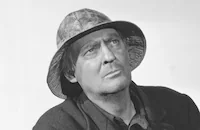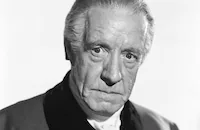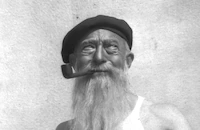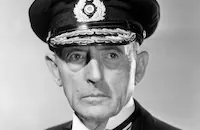Mata Hari

Brief Synopsis
Cast & Crew
George Fitzmaurice
Greta Garbo
Ramon Novarro
Lionel Barrymore
Lewis Stone
C. Henry Gordon
Film Details
Technical Specs

Synopsis
In 1917 during World War I, France deals summarily with traitors and spies. After presiding over the execution of the latest group of convicted spies, Dubois, chief of the French Spy Bureau, vows that he will someday find enough evidence to prosecute France's greatest enemy, Mata Hari, a German spy posing as a dancer. Mata, a resident of Paris, receives her assignments from a man named Andriani, who instructs the beautiful agent to use her charms to procure messages and maps detailing Russian troop movements. Soon after meeting the handsome Lieutenant Alexis Rosanoff of the Russian Imperial Air Force, a flier who was celebrated for his successful flight over German lines to bring back a secret message, Mata begins an affair with him. Mata, who initially does not know that Alexis possesses the very documents she has been ordered to steal, falls in love with him. Later, when Mata learns that Alexis is carrying the secret documents, she sleeps with him and darkens the apartment so that her fellow agents can take the papers, copy them and return them without notice. The ruthless Andriani, who believes that a spy is permitted no friends, emotions or personal life, has Carlotta, one of his spies, killed for falling in love on the job. After this, he tells Mata that she must continue her relationship with Alexis without becoming attached to him. Using a different tactic to get the evidence he needs to snare Mata, Dubois tells General Shubin, Mata's ex-lover and former accomplice, that Mata has been having an affair with Alexis, hoping that his jealous rage will result in him exposing her treachery. As predicted, Shubin angrily confronts Mata, and Mata tries to prove that she does not love Alexis by showing Shubin the secret photographs she stole from the young lieutenant. Not convinced, Shubin places a call to the embassy in order to have Mata arrested, but Mata shoots him before he can reveal her. After begging Alexis to leave and forget that he ever knew her, Mata flees from the murder scene. Fearful of what might happen to his espionage operation now that Mata has murdered Shubin, Andriani tells her that her Paris assignment is over and that she must now go to Amsterdam to avoid harm. Before Mata leaves, however, Andriani informs her that Alexis has been injured in an airplane crash and has been hospitalized. When Andriani forbids her to visit Alexis, Mata resigns from the spy ring and goes to her lover. At his bedside, Mata promises the blinded Alexis that she will never leave him again. As soon as Mata leaves the hospital, though, she is arrested by Dubois and put on trial for murder and espionage. In order to prevent Alexis from ever knowing about her crimes, Mata pleads guilty before the prosecution can call him to the witness stand. Though Mata's execution has been set, she anxiously waits for a reprieve. The reprieve never comes, and just prior to her execution, Alexis, having been told that she is in a sanitarium awaiting an operation, visits her and is fooled into thinking that the prison is a hospital. Mata asks Alexis to promise not to grieve too much if her operation fails and she dies, and she is then led outdoors, where the firing squad is prepared to execute her.

Director

George Fitzmaurice
Cast

Greta Garbo

Ramon Novarro

Lionel Barrymore

Lewis Stone

C. Henry Gordon

Karen Morley

Alec B. Francis
Blanche Frederici

Edmund Breese
Helen Jerome Eddy

Frank Reicher
Lennox Pawle

Mischa Auer

Cecil Cunningham
Michael Visaroff
Sarah Padden

Harry Cording
Crew
Adrian
Doris Anderson
Leo Birinski
James Brock
Milton Brown
Gilbert Emery
B. P. Fineman
George Fitzmaurice
Cedric Gibbons
Benjamin Glazer
A. L. Lane
Fred R. Morgan
Paul Neal
Charles W. Riley
Albert Scheving
Douglas Shearer
Frank Sullivan
H. Cullen Tate

Videos
Movie Clip




Trailer
Film Details
Technical Specs

Articles
Mata Hari
1931 was the year of the dueling Matas. Marlene Dietrich had been brought to the U.S. as Paramount's European bombshell, to rival MGM's top star, Greta Garbo. When Paramount executives learned that Garbo was to play Mata Hari, they rushed Josef von Sternberg's Dishonored (1931) into production, starring Dietrich as a Mata Hari-like spy. Dishonored opened in March, and in December, Mata Hari (1931), starring Greta Garbo premiered.
MGM's version of the famous spy was tailored to Garbo's screen persona: a world-weary sophisticate made noble and self-sacrificing by love. Like the real Mata Hari, Garbo's Mata makes her living as an exotic dancer, and as a courtesan to highly placed officials on both sides of the conflict. Her affairs with a General (Lionel Barrymore) and a young Russian aviator (Ramon Novarro) prove to be her undoing.
Garbo makes a dazzling entrance, performing a quasi-Oriental dance which ends in a discreet striptease. (The Variety reviewer called it a "polite cooch.") It's likely that parts of the dance were performed by one of Garbo's doubles. That part of the film, at least, is based on the real Mata Hari, who had lived in Java and claimed to have learned her dances there. The name "Mata Hari" was supposedly Malay for "eye of the dawn." But the true story was sadder, shabbier and murkier than the movie versions. Born Margaretha Gertrud Zelle in the Netherlands, she married and went to Java. The marriage failed, and she moved to Paris, scandalizing polite society by dancing nearly nude. By the time World War I came, she was pushing forty and less in demand. She turned to spying for extra money, and was probably a double agent. In 1917, Mata Hari was captured and executed by the French. Some believe she was a scapegoat, that her assignments were minor and produced no information of any value. Legend has it that she refused a blindfold and blew kisses to her executioners just before they shot her. A museum in her hometown of Leeuwarden, Holland features a "Mata Hari Room," with photographs, love letters, costumes and jewelry.
Garbo's Mata Hari, of course, was a grander and more tragic figure. Also more glamorous, thanks to the bejeweled exoticism of Adrian's costumes, which helped define the character. By the end of the film, the costumes, like the character, are pared and purified to essentials. Garbo dominated love scenes with Novarro with her usual frank eroticism. One scene, when she seduces him in front of an icon of the Virgin Mary, was too libidinous for the British censors. In the British version, the icon was changed to a portrait of somebody's mother. Critics enjoyed making fun of the stars' accents (at one point, Novarro had a line which sounded like "what's the mata, Mata?"), but felt that Garbo elevated Mata Hari beyond its more ludicrous elements. Mordaunt Hall, in the New York Times, said, "there is...enough truth to make a most compelling melodrama." There have been other movie Matas before and since, but many fans agree with Screen Book that "the real Mata Hari was a colorful person, but she could in no way touch the personality displayed by the Swedish star."
Director: George Fitzmaurice
Producer: Irving Thalberg (uncredited)
Screenplay: Benjamin Glazer and Leo Birinksy
Editor: Frank Sullivan
Cinematography: William Daniels
Costumes: Adrian
Principal Cast: Greta Garbo (Mata Hari), Ramon Novarro (Lt. Alexis Rosanoff), Lionel Barrymore (General Serge Shubin), Lewis Stone (Andriani), C. Henry Gordon (Dubois), Karen Morley (Carlotta)
BW-89m Closed captioning.
by Margarita Landazuri

Mata Hari
Quotes
The only way to resign from our profession is to die.- Andriani
A spy in love is a tool that has outlived its usefulness.- Andriani
Trivia
Major Thomas Coulson's 1930 book, "Mata Hari; Courtesan and Spy" peaked interest in filming the movie, but an MGM executive said that no one book was the basis of their movie. Mata hari translates to "eye of the dawn" in Hindustani. Censors of may cities required cuts in the movie, which was typical of many pre-code movies. When MGM applied to the Hayes office for a certificate in 1936 for re-release, it was refused. However, a certificate was issued in 1939, when the movie was re-released.
Notes
This film was based on the true story of Mata Hari, the assumed name of Margaretha Geertruida MacLeod (née Zelle), and her espionage activities during World War I. According to the file for the film in the MPAA/PCA Collection at the AMPAS Library, in April 1930, Paramount producer Ben Schulberg asked the opinion of the Hays Office on doing a picture based on the book Mata Hari by Major Thomas Coulson of the British Intelligence Service. The Hays Office forwarded the book to the German Consul General in San Francisco, Otto von Hentig, who called it "one of the most contemptible pieces of war propoganda I ever read" and claimed that every detail of the story was "utterly wrong or misconceived." The Consul General also complained that in the story Germans were "once again the treacherous, cunning nation compared with these gallant and clever French and English men." At least one official at the MPPDA, Maurice McKenzie, shared von Hentig's opinion that Coulson's story should not be filmed and called it "a dangerous one to deal with from both the French and German standpoint."
Paramount eventually abandoned its plans to film the story, but M-G-M took up the idea and submitted a temporary script of Mata Hari a year later. According to a December 1931 New York Times article, an M-G-M executive asserted that "no single book written about the adventuress's exploits was used as authority for the film narrative." The Hays Office called M-G-M's version "a very strong story and an interesting one." Initially, the only objections raised by the Hays Office to the M-G-M script were those concerning Mata's dance sequence and the "bedroom situations." By August 1931, however, M-G-M was warned about, among other things, Mata's nudity, her sexual affairs and the portrayal of nuns as "parties to an illicit sexual affair."
Hollywood Reporter pre-production news items note that Jean Hersholt was set for a part in this film and that the start of filming was delayed due to story difficulties. Although a November 1931 Film Daily news item notes that actress Isabel Keith was signed to a role, her appearance in the released film has not been confirmed. Modern sources credit J. K. Brock with the sound and list Gordon De Main in the role of "Ivan." According to a New York Times news item, the Aggoure ranch, located about fifty miles from Hollywood in the Sherwood Lake region, was used as the location for the execution scenes in this picture. The New York Times also indicates that, in order to "insure the accuracy of treatment and curtail production delays," director George Fitzmaurice adopted an experimental plan of using over 300 drawings prepared by studio draftsmen to supplement his continuity sheet. The drawings, which were supervised by Fitzmaurice and Alexander Toluboff of the studio art department, included detailed pictorial compositions of the settings, the positioning of players and specifications for lighting and camera angles. The New York Times review notes that "Mata Hari" translates to "eye of the dawn" in Hindustani.
According to the MPAA/PCA file, in December 1931, New York censors ordered many eliminations from the film, including the scene in which Novarro picks up Garbo from a couch, carries her into a bedroom and slams the door; the subsequent view of the city at dawn; Garbo lighting the Madonna lamp; and "Andriani's" men carrying out "Carlotta's" body. The Atlanta Better Film Committee reviewed the film in January 1932 and gave it a "not recommended" rating. The reviewer commented, "I wish this picture could be destroyed. It is not fit to be shown anywhere." In January 1936, a PCA official who reviewed the film to determine its eligibility for re-issue certification recommended against certification and wrote that the film was "the type of picture which caused adverse criticism of the motion picture industry." Although the PCA submitted a new list of required deletions to qualify Mata Hari for re-issue certification, the film was rejected that year. The picture did not receive a re-issue certification number until July 1939.
Among the many films based on the legendary spy are: a 1927 German film entitled Mata Hari, directed by Frederich Feher and starring Madga Sonia; a 1965 French-Italian production entitled Mata Hari, Agent H-21, directed by Jean-Louis Richard, and starring Jeanne Moreau and Jean-Louis Trintignant (see AFI Catalog of Feature Films, 1961-70; F6.3137); and the 1985 film Mata Hari, directed by Curtis Harrington and starring Sylvia Kristel and Christopher Cazenore. In addition, Mata Hari was caricatured by Zsa Zsa Gabor in the 1972 British film Up the Front.

Miscellaneous Notes
Released in United States 1932
Released in United States 1932














